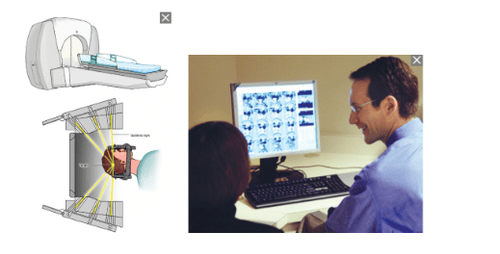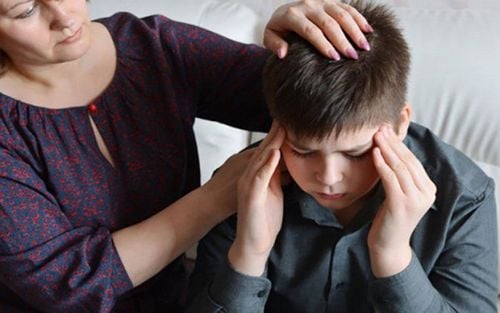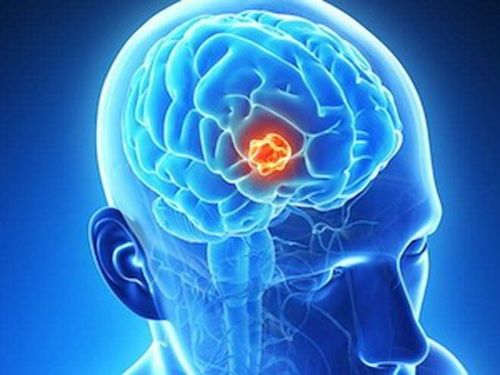This is an automatically translated article.
Posted by Doctor Nguyen Kim Chung - Department of General Surgery, Vinmec Central Park International General Hospital
A brain tumor is a growth of abnormal cells in the brain. There are many types of brain tumors. Some brain tumors are benign, and some are malignant. Brain tumors can start in your brain (primary brain tumor) or cancer can start in other parts of your body and spread to your brain (secondary or metastatic tumor).
1. Brain Tumor Overview
Brain tumors have different growth rates. The growth rate as well as the location of a tumor determine how it will affect the function of the nervous system. Treatment options depend on the type of tumor, as well as its size and location.
Common types of brain tumors include:
Acoustic neuroma Astrocytoma Brain metastasis Carcinoma choroid plexus Craniopharyngeal tumor Embryonic tumor Meningioma glioma Glioblastoma Myeloblastoma Meningiomas Oliodendroglioma Brain tumors in children Pinealblastoma Pituitary tumors

Các lựa chọn điều trị phụ thuộc vào loại u, cũng như kích thước và vị trí của nó.
2. Symptoms of brain tumor
Brain tumor symptoms vary widely and depend on the size, location, and growth of the tumor
General signs and symptoms of a brain tumor include:
New onset or change in headache pattern Headache the headache gradually becomes more frequent and severe Unexplained nausea or vomiting Vision problems, such as blurred vision, double vision, or loss of peripheral vision Gradual loss of sensation or movement in one area arms or legs Difficulty with balance Difficulty speaking Confusion in everyday problems Personality or behavior changes Seizures, especially in people with no history of seizures Hearing problems

Nhức đầu là dấu hiệu phổ biến của u não
3. Causes of brain tumors
Brain tumor causes include:
First: Tumors that form inside the brain
Primary brain tumors that originate in the brain itself or in nearby tissues, such as the meninges, cranial nerves, pituitary or pineal gland..
Primary brain tumors begin when normal cells have errors (mutations) in their DNA. These mutations allow cells to grow and divide at an accelerated rate and continue to grow when healthy cells die. The result is the formation of a mass of abnormal cells, forming a tumor.
In adults, primary brain tumors are much less common than secondary brain tumors (tumors that start elsewhere and spread to the brain)
Many different types of primary brain tumors exist. Each type is named after the cell type involved. Some examples:
Glioblastomas: These tumors start in the brain or spinal cord and include astrocytomas, meningiomas, glioblastomas, oligoastrocytomas, and oligoastrocytomas. thorn. Meningioma: A meningioma is a tumor that arises from the membranes that surround your brain and spinal cord. Most meningiomas are benign. Acoustic neuromas (schwannomas). These are benign tumors that develop on the nerves that control balance and hearing that lead from your inner ear to your brain. Pituitary tumors: These are mostly benign tumors that develop in the pituitary gland at the base of the brain. These tumors can affect pituitary hormones with effects throughout the body. Myeloblastoma: This is the most common type of malignancy in children. A mediastinal tumor begins in the lower part of the brain and tends to spread through the spinal fluid. Less common in adults, but still cases. Germ cell tumors: Germ cell tumors can develop during childhood, where the testicles or ovaries will form. But sometimes the tumor affects other parts of the body, such as the brain. Craniopharyngioma : Rare, benign. The tumor begins near the brain's pituitary gland, which secretes hormones that control many body functions. As the tumor grows, it can affect the pituitary gland and other structures near the brain. Second: Tumors that form outside and spread into the brain
Secondary brain tumors often occur in people with a history of cancer. But in rare cases, a metastatic brain tumor can be the first sign of cancer starting elsewhere in your body.
In adults, secondary brain tumors are much more common than primary brain tumors.
Any cancer can spread to the brain, but common types include:
Breast cancer Colon cancer Kidney cancer Lung cancer Melanoma Third: Risk factors
In In most people with primary brain tumors, the cause of the tumor is not clear. But doctors have identified several factors that can increase the risk of brain tumors:
Exposure to radiation: People who have been exposed to ionizing radiation have an increased risk of brain tumors. Examples: radiation therapy used to treat cancer, radiation exposure due to atomic bombs. Family history of brain tumors: Some patients have brain tumors that occur in people who have a family history of brain tumors or have a family history of genetic syndromes that increase the risk of brain tumors.

Ung thư vú có thể lan sang u não
4. Diagnosis of brain tumor
If your doctor suspects you have a brain tumor, your doctor may recommend a number of tests and procedures, including:
Neurological exam: checking vision, hearing, balance, coordination, strength and reflexes radiation. Difficulty performing the test can provide clues as to which part of the brain is affected by the tumor. Imaging: Magnetic resonance imaging (MRI) is often used to help diagnose brain tumors. In some cases, dye may be injected through a vein in your arm during your MRI scan. Several types of specialized MRI — including functional MRI, perfusion MRI, and magnetic resonance spectroscopy — can help doctors evaluate tumors and plan treatment. Sometimes other imaging techniques are recommended: including computed tomography (CT). Positron emission tomography (PET) can be used to take pictures of the brain, but is generally not as helpful in creating images of brain cancer as it is for other types of cancer. Tests to look for cancer in other parts of your body: If it is suspected that your tumor may be the result of cancer that has spread from another area of your body, your doctor may recommend recommend tests and procedures to determine where the cancer is coming from. An example might be a CT or PET scan to look for signs of lung cancer. Collect and test a sample of abnormal tissue (biopsy): A biopsy may be done as part of surgery to remove a brain tumor, or by using a needle. A stereotactic biopsy can be done for brain tumors in hard-to-reach areas or very sensitive areas of your brain that might be damaged by extensive surgery. The surgeon will drill a small hole into your skull. A thin needle is then inserted through the hole. Tissue is removed with a needle, often guided by a CT or MRI scan. The biopsy sample is then viewed under a microscope to determine if it is malignant or benign. More sophisticated lab tests can give your doctor clues about your prognosis and treatment options.
5. Brain Tumor Treatment
Treatment for a brain tumor depends on the type, size and location of the tumor, as well as your overall health and preferences.
5.1 Surgery
If the brain tumor is located in an accessible place, during surgery, the surgeon will try to remove as much of the tumor as possible.
In some cases, tumors are small and easily separate from surrounding brain tissue, so they can be completely removed. In other cases, tumors cannot separate from surrounding tissues or they are located near sensitive areas in your brain, making surgery dangerous. In these situations, your doctor will try to remove as much of the tumor as possible within a safe threshold
Even removing part of a brain tumor can help reduce your signs and symptoms.
Surgical removal of the tumor carries risks, such as infection and bleeding. Other risks may depend on the part of your brain where your tumor is located. For example, surgery on a tumor near a nerve that connects to the eye can cause you to lose vision.

Phẫu thuật giúp điều trị u não
5.2 Radiation therapy
Radiation therapy uses high-energy beams, such as X-rays or protons, to destroy tumor cells. Radiation therapy may be machined (external beam radiation), or, in very rare cases, radiation may be placed inside the body close to your brain tumor (proximal radiotherapy)
Radiation The external beam can focus only on the area of your brain where the tumor is located, or it can be applied to your entire brain (whole brain radiation). Whole-brain radiation is often used to treat cancer that has spread to the brain from some other part of the body and formed multiple tumors in the brain.
A newer form of radiation therapy using proton beams is being studied. For tumors that are very close to sensitive areas of the brain, proton therapy can reduce the risk of radiation-related side effects. But proton therapy has not been shown to be more effective than standard radiotherapy with X-rays.
Side effects of radiation therapy depend on the type and dose of radiation you receive. Common side effects during or shortly after radiation therapy include fatigue, headache, memory loss, and scalp irritation.
5.3 Radiosurgery
SRS radiosurgery is not a form of surgery in the traditional sense. Instead, radiosurgery uses multiple beams of radiation that deliver a highly focused radiation to destroy tumor cells in a very small area. Each beam of radiation is not strong, but the point where all the beams meet - at the brain tumor - receives a very large dose of radiation to destroy the tumor cells.
There are different types of technology used in radiosurgery to treat brain tumors, such as the Gamma Knife or the linear accelerator.
Radiosurgery is usually done in one treatment and in most cases you can go home the same day.

Có nhiều loại công nghệ khác nhau được sử dụng trong xạ phẫu để điều trị các khối u não
5.4 Chemotherapy
Chemotherapy uses drugs to kill tumor cells. Chemotherapy drugs can be taken by mouth as a pill or injected into a vein. The chemotherapy drug used most often to treat brain tumors is temozolomide (Temodar), which is taken as a pill. Many other chemotherapy drugs are available and may be used depending on the type of cancer.
The side effects of chemotherapy depend on the type and dose of the drug you receive. Chemotherapy can cause nausea, vomiting, and hair loss.
Tumor cell testing can determine whether chemotherapy will be helpful to you. The type of brain tumor you have is also helpful in determining whether chemotherapy should be recommended.
5.5 Targeted treatment
Targeted treatment focuses on specific abnormalities present in cancer cells. By blocking these abnormalities, drug treatments can cause cancer cells to die.
Targeted drugs are available for some types of brain tumors. Many others are being studied in clinical trials. Various forms of targeted therapy are being developed.
6. Recovery after treatment
Because brain tumors can develop in the parts of the brain that control motor skills, speech, vision, and thinking, rehabilitation may be needed. Depending on your needs, your doctor may refer you to:
Physical therapy to help you regain lost motor skills or muscle strength Occupational therapy to help you return to activities normal day-to-day, including work, after a brain tumor or other illness Speech therapy with speech therapists (speech pathologists) to help if you have trouble speaking Teach tutoring for school-age children to help them cope with changes in memory and thinking after a brain tumor. When seeing some of the above warning signs of brain tumors or any other abnormal signs of the body, patients need to go to medical facilities so that doctors can diagnose the disease as soon as possible. Vinmec International General Hospital is the leading effective treatment center for brain tumors in particular and neurological diseases in general.
With fully equipped with modern equipment, the most advanced machines today such as: G.E 3.0 CT scanner (MRI), CT SCAN Toshiba 640 slices, cerebral angiogram, MRA and CTA... Doctors at Vinmec can easily detect, diagnose, and plan treatment thanks to the clear and detailed images obtained. Not only brain tumors, but also effectively applied to other brain and spinal diseases such as: brain degeneration, traumatic brain injury, cerebrovascular disease, cerebral aneurysm... The patient was treated and Rehabilitation in modern wards, fully equipped with international standards, helping patients feel comfortable, maximum support for the treatment process. Customers can directly go to Vinmec health system nationwide to visit or contact the hotline here for support.













